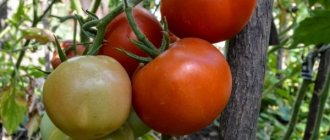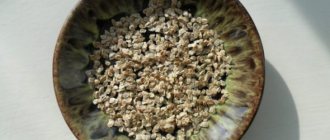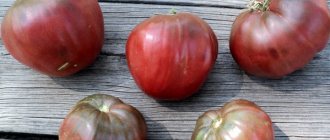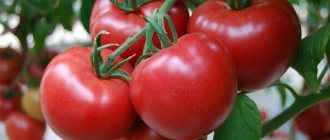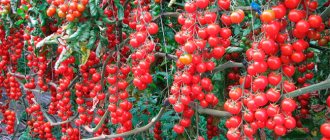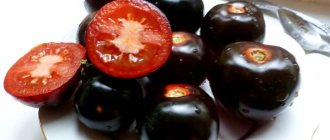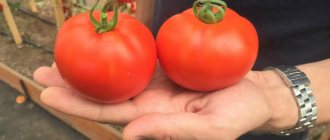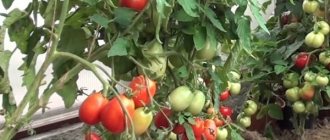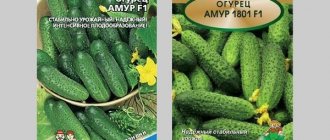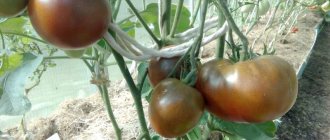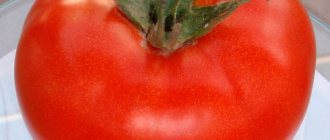A breeding group of scientists from Chelyabinsk presented an interesting hybrid to tomato lovers. Red red F1 belongs to the newest generation of tomatoes and has many positive properties. Among the indisputable bonuses are adaptation to various weather conditions (bad weather, cold snap, heat), stable productivity, and the possibility of universal cultivation.
| Height | Landing location | Ripening time | Fruit color | Fruit size | Origin | Fruit shape |
| Tall | Greenhouse, Open ground | Early ripening | Reds | Large | Hybrid | Round |
Description of tomatoes Red Red F1
This hybrid has extremely high consumer properties. Tomato Krasny Krasno f1 can be safely recommended for planting to all gardeners who have greenhouses and greenhouses. This tomato variety is characterized by early yield, large number of fruits and resistance to diseases. These qualities will undoubtedly appeal to many who want to grow Red Red tomatoes on their plots.
This tomato variety belongs to the mid-season and indeterminate species and is a high-yielding first-generation hybrid. Tomatoes ripen in 110–115 days, have a flat-round shape with pronounced ribbing at the stalk.
The bush grows spreading, with increased formation of green mass. Anyone who has already planted a Red Red tomato knows that the bush must be formed and tied up. The leaves of this hybrid tomato are usually medium in size and dark green in color. The fruits are formed in clusters of 5-7 pieces.
Tomato Red Krasno f1 compares favorably with other varieties with increased productivity. One bush can produce more than 8 kg of aromatic and tasty tomatoes. In the formation phase, tomatoes have a light green color, which as they ripen changes to the traditional deep red color.
The fruits of this tomato variety grow quite large. On average, their weight can reach 200-300 grams. The peel, despite its small thickness, prevents cracking of the fruit well. The tomato variety Red Krasno f1 (reviews and photos can be seen below) is distinguished by moderately juicy pulp. It is fleshy, loose, contains few seeds and is sugary at the break. The taste of tomatoes is very rich, sweet with a slight hint of sour. Red Red tomatoes contain large amounts of sugar and healthy microelements.
This subspecies can be grown in any region, excluding the northern ones. The Red Red tomato variety shows the best yield results when grown in greenhouses or film greenhouses. If climatic conditions permit, you can grow tomatoes in open ground. But this is only possible in the southern regions of Russia.
If the timing and cultivation rules are followed, the first harvest will ripen at the end of June, and this tomato variety will bear fruit until the fall. The harvest is stored well after harvest. Handles transportation well. With short-term storage and transportation, the taste and presentation of tomatoes do not decrease. The fruits, if picked unripe, ripen well at home.
Judging by the description and characteristics, the Red Red tomato is classified as a salad variety in terms of its area of application. They are suitable for consumption in their natural form. You can also prepare various snacks, salads and soups from tomatoes of this variety. Tomatoes can be stuffed and used to decorate the holiday table.
Description of fruits
The features of the fruits of the hybrid variety F1 include:
- their rounded, slightly flattened shape with slight ribbing at the base;
- thin but durable skin that protects tomatoes from cracking;
- bright rich red color of tomatoes, corresponding to the name of the variety Red Red;
- juicy fleshy pulp with a sugary structure;
- small number of seeds;
- sweet, with a slightly noticeable sourness, taste;
- high keeping quality and transportability of tomatoes;
- ability to ripen at room temperature;
- versatility in use - tomatoes are good both fresh and prepared.
Characteristics of the tomato variety Red Red
The tomato variety Red Red is characterized by the ability to self-pollinate. It is for this reason that it is excellent for growing in greenhouses. The tomato was bred with the aim of obtaining the highest possible yields in record time. And the variety fully corresponds to the declared characteristics. However, to guarantee high yields, it is recommended to adhere to the rules of agricultural technology.
If the rules for caring for tomatoes are violated, a sharp decrease in yield is observed.
Advantages and disadvantages of the variety
Like all hybrids, the Red Red tomato has positive characteristics. The most outstanding advantages of the variety include the following:
- high productivity;
- the harvest ripens in waves;
- long fruiting period - from July to September;
- large fruit;
- excellent taste of tomatoes;
- quite wide scope of application;
- possibility of long-term storage;
- resistance to sudden temperature changes;
- high resistance to major tomato diseases.
The disadvantages that, alas, each variety has include the need for tying and proper formation of bushes. Regular removal of stepchildren is a mandatory procedure for obtaining rich harvests.
Another significant disadvantage is the impossibility of harvesting seed material from grown tomatoes. The variety is a hybrid, which means that the varietal characteristics of the Red Red tomato will not be preserved in subsequent generations. This feature is common to all hybrids.
The obvious disadvantages of the variety include:
- due to the height and spreading nature of the bush, special attention should be paid to gartering and regular removal of stepsons;
- the need to buy seed every year;
- the variety's demands on soil composition.
But all these disadvantages are more than compensated for by high yields and excellent taste.
Microclimate in the greenhouse
Air temperature is 20-33 C - under such conditions, the “Red Red” tomato develops best. The characteristics and description of the variety provided by the manufacturer allow us to judge it as very hardy. However, despite this, the greenhouse should still be ventilated periodically. If the air temperature in the greenhouse rises above 35 C, the tomato pollen will become sterile and fruits will not set on the bushes.
The “Red Red” variety, as already mentioned, belongs to the group of self-pollinating ones. The greenhouse owner does not need to perform any special actions to set fruit when growing this hybrid. The only thing is that from time to time it is advisable to lightly shake the trellises along the entire length of the bed (about once a week).
Growing red tomatoes
The process of growing this variety of tomatoes takes a lot of effort and time. Tomatoes are grown exclusively in seedlings. Before planting in the soil, it will not be superfluous to treat the seeds with a growth stimulant.
The best soil for the Red Red tomato variety is a mixture of turf with humus or peat with ready-made soil, which is sold in stores. To make the soil even lighter and airier, you can add a little well-washed river sand to it. To increase the content of nutrients, wood ash is added.
Red Red tomato seeds are planted to a depth of 1.5-2 centimeters, watered abundantly and the containers are covered with film. For sprouts to appear, a constant temperature of 25˚C must be maintained. Plantings need to be moistened regularly.
Immediately after the first shoots appear, the film is removed from the boxes. To grow strong and healthy seedlings, it is necessary that tomatoes receive enough sunlight. In low light conditions, fluorescent lamps can be used.
Productivity
This hybrid is relatively new - the Red Red tomato. Photos of the fruits and bushes of this variety clearly demonstrate its good qualities. Some summer residents have already managed to appreciate its advantages in practice. Judging by the reviews, the yield indicators of this variety are quite good. The manufacturing company claims that 8-9 kg of tomatoes can be harvested from just one “Red red” bush. Of course, not all summer residents achieve such high performance from this variety. However, gardeners still consider it somewhat more productive than many other modern hybrids. In most cases, summer residents collect about 5 kg of fruits per season from each bush of this variety.
Diseases and pests
The Red Red tomato variety is quite resistant to various diseases. It is practically not susceptible to diseases such as leaf spot, gray and apical rot, fusarium and verticillium. To strengthen security measures, you can organize a set of preventive measures:
- follow crop rotation recommendations;
- you need to update the top layer of soil in the greenhouse every year, watering it in early spring with a pink solution of potassium permanganate or copper sulfate;
- plants must be periodically treated with phytosporin or a similar biological product.
When suffering from late blight, it is necessary to treat the bushes with preparations containing copper. Infected fruits and leaves must be immediately destroyed.
Red tomatoes are also damaged by slugs, Colorado potato beetles, whiteflies and aphids. To reduce the risk of pests in the garden beds, tomatoes need timely weeding, mulching of the soil and regular ventilation of the greenhouse or greenhouse.
To kill aphids, wash the stems and leaves of tomatoes with warm soapy water or a weak solution of potassium permanganate. Insecticides control flying pests. Tomatoes need to be processed two or three times with an interval of several days.
Attention!
The use of potent toxic drugs is possible only before flowering begins. Then they are replaced with herbal infusions. Usually these are celandine, onion peel and chamomile.
Overall, growing Red Red tomatoes is not such a difficult task. Even a novice gardener can cope with the rules of agricultural technology. And the reward for your labors will be a bountiful harvest of tasty and sugary tomatoes.
Planting and care
You need to sow seeds for seedlings depending on the climatic characteristics of the region. This is usually done in April-May, but it can be done earlier. If the greenhouse is not yet ready, the seeds are first sown in special pots. Replanting is carried out when the first leaves appear.
As for further care, you need to do the following:
- Feed with appropriate fertilizers.
- Maintain a certain temperature regime if tomatoes are grown in a greenhouse.
- Ventilate the greenhouse if it is very hot.
- Water abundantly.
- Carry out systematic pruning of the bush.
- Tie branches to supports to prevent crop loss.
Expert opinion
Stanislav Pavlovich
Gardener with 17 years of experience and our expert
Ask a Question
Important. Before transplanting seedlings into the greenhouse, you need to make sure that there will be no more frosts.
Preparation of the site and planting material
Seeds purchased in a store are not treated with any additional solutions. They are already protected from fungus. Before sowing, it is important to properly prepare the soil. It doesn’t matter how the seedlings grow - in separate containers or directly in the greenhouse.
To obtain soil, mix peat, river sand and soil. Wood ash or humus is also added. Any container is suitable as a container for sowing. The main thing is that it should not be less than 15 cm in height.
Planting dates and patterns
Tomatoes are usually sown in a container in March, so that the seedlings can be transplanted into a greenhouse at the end of April or directly into open ground in May. The distance between the rows is 1 m, and between the bushes - 50 cm. That is, in a greenhouse per 1 sq. m. m. there should be 4 bushes, and in open ground - 3 plants.
Seeds
After the soil for sowing is prepared, it is poured into appropriate containers. Then water well. It is better to start sowing the next day:
- make small grooves (no more than 2 cm);
- the seeds are placed at a distance of 2-4 cm from each other;
- cover with a small amount of soil.
In order for the seeds to hatch faster and the first shoots to appear, you need to place the future seedlings in a room with a temperature of at least +25°C. As soon as the shoots appear, the boxes should be moved to the windowsill. During this period of time, seedlings require a lot of light, so additional lamps are used.
Seedlings
Before transplanting seedlings into a greenhouse, you need to harden them off. To do this, the boxes are taken outside every day. Hardening is carried out gradually, starting from 10 minutes. Once the weather is warm enough for replanting, the tomatoes are placed in soil. So that the seedlings take root well and do not break from the wind, hilling is carried out. Tomatoes are planted in open soil in a similar way.
Watering and fertilizing mode
The hybrid variety Krasny Krasno tolerates lack of moisture well, but this sometimes affects the taste of the crop. Therefore, after planting a tomato, it is important to keep the soil moist. To do this, use the following methods:
- mulching the soil with straw or peat;
- drip irrigation;
- loosening the soil and weeding.
See also Chocolate Tomato: variety yield and growing rules
Only settled water is used for irrigation. At the same time, we must not forget about applying fertilizers, as this also affects the yield. But you need to remember these rules:
- until the flowers appear, the seedlings are fertilized with nitrogen mixtures;
- after the appearance of the first inflorescences, potassium or phosphorus fertilizers are used;
- organic fertilizers are applied rarely and in small quantities (this leads to an increase in nitrates).
Fertilizers should not be overused, as this can negatively affect the yield and quality of the fruit.
How to pinch and shape a bush
Seedlings of this variety must be properly trimmed and then tied to supports. If this is not done, then diseases and pests will appear, and the bush itself will easily break under the weight of the fruit. The rules for forming a bush are simple:
- For efficient growth, it is recommended to leave one stem.
- All shoots that appear above the third brush are removed.
- Small flowers are removed to form a stronger ovary.
- The lower leaves are removed to increase the light level, which, in turn, affects the accumulation of sugar content in the fruit.
Tying the bush is considered a mandatory procedure. It is carried out in several stages - immediately after planting the seedlings on open soil, and then every 10-15 days.
Prevention from diseases and pests
This variety of tomatoes, like others, is susceptible to all sorts of diseases and pests. Breeders managed to make it resistant to most common diseases (fusarium, rot, blight), but prevention remains the best defense.
It is necessary to treat the soil before planting using copper sulfate. You cannot plant tomatoes after potatoes or eggplants. It is better to do this after legumes, carrots or dill. At the first signs of late blight and other diseases, the bushes should be treated with preparations containing copper. When fighting insects, special insecticides will help.
Reviews of tomato Red Krasno
Svetlana, Samara I read about positive reviews of Red Red tomatoes on the Internet. The high cost of seeds is fully justified by the positive qualities of the variety. The first harvest was tasted at the beginning of July. The tomatoes grew very large and beautiful, all of the correct shape. Their flesh is very dense. My kids really liked the taste of tomatoes. Therefore, most of the harvest went to fresh summer salads. There's almost nothing left for preparations. Next year I plan to plant more.
Alexandra, Magnitogorsk The yield of the variety for our climate was pleasantly pleasing. During the entire growing period, the tomatoes did not suffer from any disease, the fruits were all even, one to one, and did not even crack at all. When we picked the first tomatoes, we were amazed. They are very tasty, juicy, with barely noticeable sourness. All summer we cut tomatoes for salads. We rolled up several cans for the winter. What I especially liked: if you cut the tomatoes into pieces before putting them in a jar, they retain their shape and do not spread.
How to fertilize
The “Red Red” tomato, like most other tall hybrids, should be fed approximately once every 2-3 weeks. For the first time, plants are fertilized 20 days after planting. In this case, a mixture of 50 grams of superphosphate, 30 g of potassium sulfate and 15 g of ammonium nitrate is used. Fertilizers are dissolved in 10 liters of water and the tomatoes are watered at the rate of 1 liter per plant.
During the period of mass flowering, it is advisable to feed Red Red tomatoes using the foliar method. Spraying is usually carried out with a solution of the following composition:
- superphosphate - 10 g;
- urea - 10 g;
- potassium sulfate - 10 g;
- boric acid - 2 g;
- water - 10 liters.
The solution consumption when spraying should be approximately 0.5 liters per 10 m2 of planting.
Flaws
These are the reviews that the “Red Red” tomatoes mainly deserve. Photos of this hybrid in the beds show how powerful and strong the plant is. Gardeners have a good opinion about this variety. However, according to many summer residents, this hybrid also has one small drawback. Gardeners believe that the downside of “Red Red” is, first of all, that it is impossible to obtain high-quality seeds from it. After all, hybrids produce good yields, unfortunately, only in the first generation. Plants grown from Red Red seeds do not inherit varietal parental qualities.
